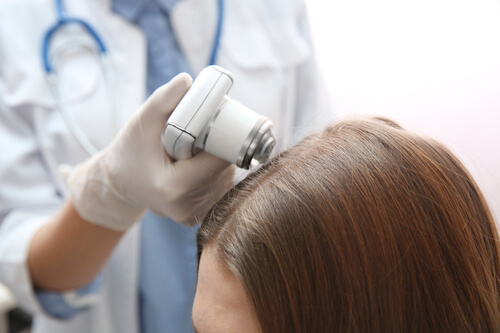In women hair loss isn’t as straightforward as it is in the majority of men. For men, nearly 90 percent of all hair loss cases are associated with male pattern baldness. However, female hair loss may be triggered due to a variety of circumstances and conditions. Some women even experience hair loss as a result of health problems or menopause.

If you have started noticing that you are losing more hair than usual, you might be researching what’s causing the problem. There are a number of ways to diagnose hair loss. One of them is through a scalp biopsy.
Scalp Biopsy
In this procedure, a small portion of the scalp is removed from the head of the patient. That portion is then examined by a dermatologist under a microscope to determine what’s causing hair loss.
The dermatologist will first clean and disinfect the area that needs to be biopsied and then mark it. Any hair that is present there will be trimmed and then the area will be anesthetized. After that the dermatologist will place a punch tool on top of the area and using a needle, they will remove the excised skin. The small opening, resulting from the procedure, will then be closed.
How the Diagnosis Is Made?
After the removal of biopsy, it’s either snap frozen with the help of liquid nitrogen or stored in some kind of chemical solution. The specimen is then sliced for examination using a specialized tool. The slices are very small and each one is used separately for further examination. Each slice is examined under a microscope. Once the samples have been examined, they are stored or preserved, destroyed or sent for further testing
One important thing that dermatologist will look for is how much hairs are there in the telogen phase. Only 10 to 20 percent of hair should be present in this stage. If there are more, it means that there is a problem. Another thing that the dermatologist will look at is the health and state of the hair follicle. Are there any structural abnormities or is miniaturization occurring in any sample? These could be signs of recession and thinning resulting from Androgenetic Alopecia or other problems that affect the growth cycle.
Is a Scalp Biopsy Worth It?
A scalp biopsy may allow the dermatologist to determine what is causing your hair loss which is why it’s worth it. In order to properly treat your hair loss, it is important for the dermatologist to know the cause. When they have this information, they can target the problem and treat it more effectively.
After you receive the results from the dermatologist, you can decide how to move forward with hair loss treatment. The treatment options available to you will depend on the cause/type of hair loss. For example, if Androgenetic Alopecia is causing hair loss, the dermatologist may recommend Propecia or Rogaine.
If you have a hair loss problem, consult with your doctor and get a scalp biopsy done if they recommend it.
Join the discussion on this topic with Lilac City Momma by visiting our contact page.
